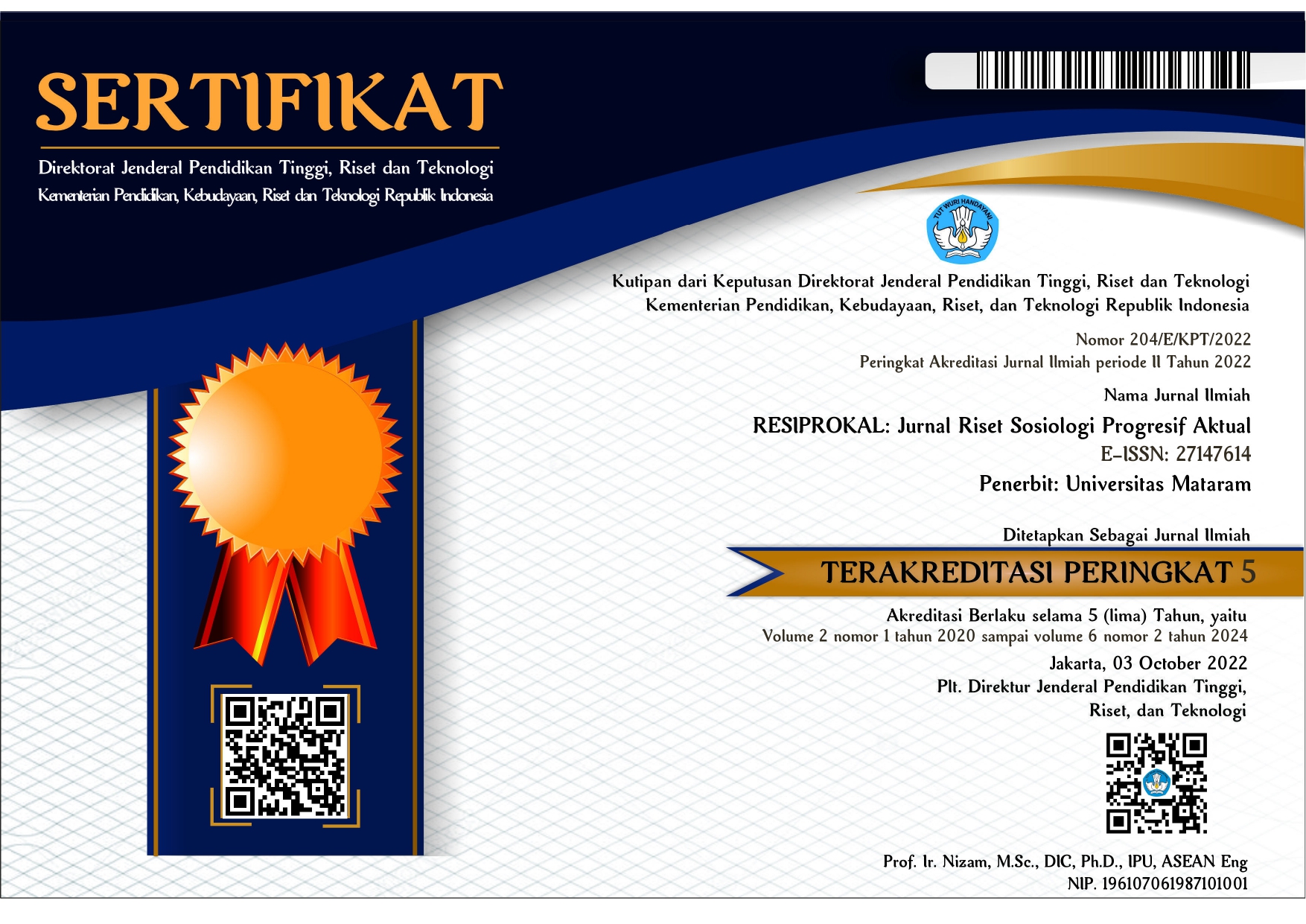Implikasi Pembangunan Pedestrian di Jalan Pancasila Kota Tegal: Kontroversi Pemanfaatan Trotoar Pejalan Kaki dan Pedagang Kaki Lima
DOI:
https://doi.org/10.29303/resiprokal.v5i2.434Keywords:
Pedestrian, Pembangunan, Kota TegalAbstract
The current misalignment with the Regional Regulation (Perwal) in utilizing pedestrian facilities on Pancasila Street, Tegal City, leads to discomfort, littering, and disorder. Policy adjustments are essential to realign usage with the city's developmental goals. This research assesses the impact of pedestrian development on Pancasila Street, particularly focusing on street vendors and pedestrians, utilizing qualitative analysis methods, including interviews and direct observations. Qualitative analysis, incorporating data coding and content analysis, is employed to understand social and economic impacts and emerging perspectives on pedestrian development. The findings highlight the need for active community participation in pedestrian planning, considering the influence of human practices and social capital on social structures and developmental decisions. While the government stresses pedestrian orderliness, community involvement is crucial for understanding social and economic impacts. In conclusion, active community participation is pivotal for optimizing positive impacts of urban infrastructure development. An educational approach is vital to raise awareness among vendors and residents, promoting rule adherence and fostering a clean, orderly, and safe urban environment. Effective collaboration among stakeholders is anticipated to create a supportive environment for all residents, including pedestrians and street vendors, ultimately contributing to sustainable economic success through transparent policies.
Downloads
References
Almulaibari, H. , dan W. N. (2011). Analisis Potensi Pertumbuhan Ekonomi Kota Tegal Tahun 2004-2008 [Doctoral dissertation]. Universitas Diponegoro.
Aotama, R. C., & Klavert, D. R. H. (2021). Dampak Sosial Relokasi Pedagang Kaki Lima di Kawasan Wisata Kuliner Kota Tomohon. SOCIA: Jurnal Ilmu-Ilmu Sosial, 18(1), 1–9. https://doi.org/10.21831/socia.v18i1.37719
Bappeda Yogyakarta. (2022). Peraturan Walikota Yogyakarta. Bappeda.
Bourdieu, P. (1977). Outline of a Theory of Practice (Vol. 16). Cambridge University Press.
Bourdieu, P. (2005). The Social Structures of The Economy. Polity.
Bourdieu, P., & Armstrong, L. (1998). Acts of Resistance: Against The New Myths of Our Time. In Labour (Vol. 44, Issue 305).
BPS Kota Tegal. (2014). Jumlah Penduduk Kota Tegal menurut Kecamatan/Kelurahan dan Jenis Kelamin. Tegalkota.Bps.Go.Id. https://tegalkota.bps.go.id/statictable/2016/01/20/35/jumlah-penduduk-kota-tegal-menurut-kecamatan-kelurahan-dan-jenis-kelamin-2014-hasil-proyeksi-penduduk-sp2010-.html
Diskominfo Kota Tegal. (2014). Kondisi Geografis Kota Tegal. Tegalkota.Go.Id. https://www.tegalkota.go.id/v2/index.php?option=com_content&view=article&id=4&Itemid=400&lang=id
El Hamdani, S., Benamar, N., & Younis, M. (2020). Pedestrian Support in Intelligent Transportation Systems: Challenges, Solutions and Open Issues. Transportation Research Part C: Emerging Technologies, 121, 102856. https://doi.org/10.1016/j.trc.2020.102856
Grenfell, M. (2010). Ed. Pierre Bourdieu: Key Concepts. Acumen Publishing Limited.
Henslin, J. M. (2006). Essentials of Sociology : A Down-To-Earth Approach. Pearson.
Hidayati, I., & Rifani, I. (2021). Mewujudkan Kota Ramah Pejalan Kaki: Kasus Kota Yogyakarta. Geographia : Jurnal Pendidikan Dan Penelitian Geografi, 2(1), 87–93. https://doi.org/10.53682/gjppg.v2i1.1039
Ikhsani, M. A., & Sari, S. R. (2023). Kajian Penerapan Prinsip New Urbanism di Jalan Ahmad Yani Kota Tegal terhadap Dimensi Fungsi dan Dimensi Sosial. Sinektika: Jurnal Arsitektur, 20(1), 39–47. https://doi.org/10.23917/sinektika.v20i1.19463
Iscahyono, F. A. , A. P. T. , D. R. (2023). Pengaruh Aktivitas Pedagang Kaki Lima terhadap Tingkat Pelayanan Jalan di Jalan Cikutra, Kota Bandung. Ge-STRAM: Jurnal Perencanaan Dan Rekayasa Sipil, 6(2).
Jabbari, M., Fonseca, F., Smith, G., Conticelli, E., Tondelli, S., Ribeiro, P., Ahmadi, Z., Papageorgiou, G., & Ramos, R. (2023). The Pedestrian Network Concept: A Systematic Literature Review. Journal of Urban Mobility, 3, 100051. https://doi.org/10.1016/j.urbmob.2023.100051
Juliana, A., Senopati, A. A., & Diana, L. (2021). Penerapan Konsep Transit Oriented Development (TOD) di Kawasan Plaza Indonesia, Jakarta. Architecture Innovation, 5(1), 1–24. https://doi.org/https://doi.org/10.36766/aij.v5i1.198
Khosasi, A. M., Kusumaningtyas, D. M., Halsted, T., & Sasongko, G. (2018). Dilema Trotoar Studi Kasus Dampak Pembangunan Trotoar terhadap Pedagang Kaki Lima di Salatiga. KRITIS, 27(2), 150–162. https://doi.org/10.24246/kritis.v27i2p150-162
Nicolas, A., & Hassan, F. H. (2023). Social Groups in Pedestrian Crowds: Review Of Their Influence on The Dynamics and Their Modelling. Transportmetrica A: Transport Science, 19(1). https://doi.org/10.1080/23249935.2021.1970651
Nino. (2022). Perwal Pedestrian Jalan Pancasila Kota Tegal Dinilai Diskriminatif Dan Tidak Konsisten.
Nugroho, M. , & R. M. (2011). Penataan Penggal Jalan Pancasila Kota Tegal [Doctoral dissertation]. Universitas Muhammadiyah Surakarta.
Setiadi, T., & Utomo, A. P. (2022). Warga dan Mahasiswa di Tegal Gelar Aksi Turun ke Jalan, Minta Wali Kota Dedy Yon Supriyono Diturunkan . https://regional.kompas.com/read/2022/03/28/233045278/warga-dan-mahasiswa-di-tegal-gelar-aksi-turun-ke-jalan-minta-wali-kota-dedy?page=all
Setiadi T., & Utomo, P. A. (2022). Warga dan Mahasiswa di Tegal Gelar Aksi Turun ke Jalan, Minta Wali Kota Dedy Yon Supriyono Diturunkan.
Tomi. (2022). Musrenbangkot, Wali Kota Sampaikan 7 Prioritas Pembangunan.
UN-Habitat. (2022). Envisaging the Future of Cities. In World City Report.
Uzunoğlu, K., & Uzunoğlu, S. S. (2020). The Importance of Pedestrianization in Cities- Assessment of Pedestrianized Streets in Nicosia Walled City. European Journal of Sustainable Development, 9(2), 589–614. https://doi.org/10.14207/ejsd.2020.v9n2p589
Wali Kota Tegal Provinsi Jawa Tengah. (2022). Peraturan Wali Kota Tegal Nomor 1 Tahun 2022 tentang Kawasan Pedestrian.
Widodo, A. S., Idayanti, S., Permanasari, D. I., & Sahri, A. (2016). Kebijakan Relokasi Pedagang Kaki Lima (PKL) di Kawasan Kota Tegal. JIP (Jurnal Ilmu Pemerintahan) : Kajian Ilmu Pemerintahan Dan Politik Daerah, 1(1), 168–188. https://doi.org/10.24905/jip.1.1.2016.168-188
Wontiana, W., & Sunarto, S. (2018). Kesenjangan Fasilitas Publik antar Kabupaten/Kota Dan Kaitannya dengan Pusat Pertumbuhan. Economics Development Analysis Journal, 5(3), 337–344. https://doi.org/10.15294/edaj.v5i3.22159








